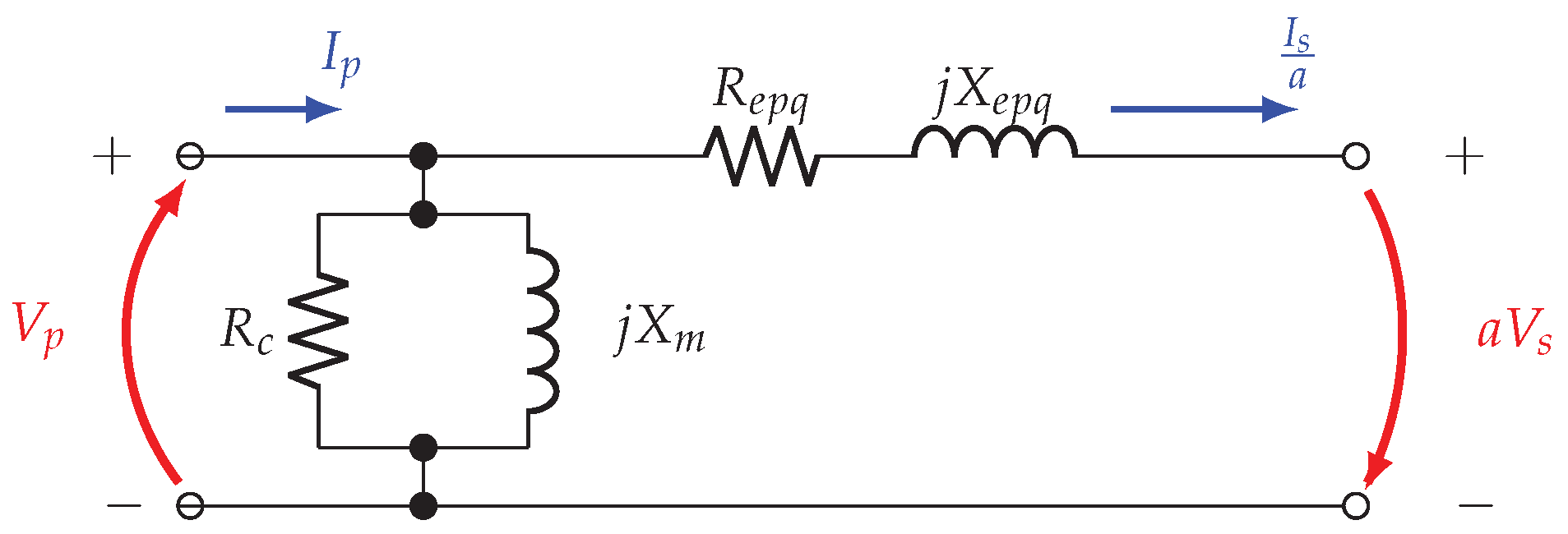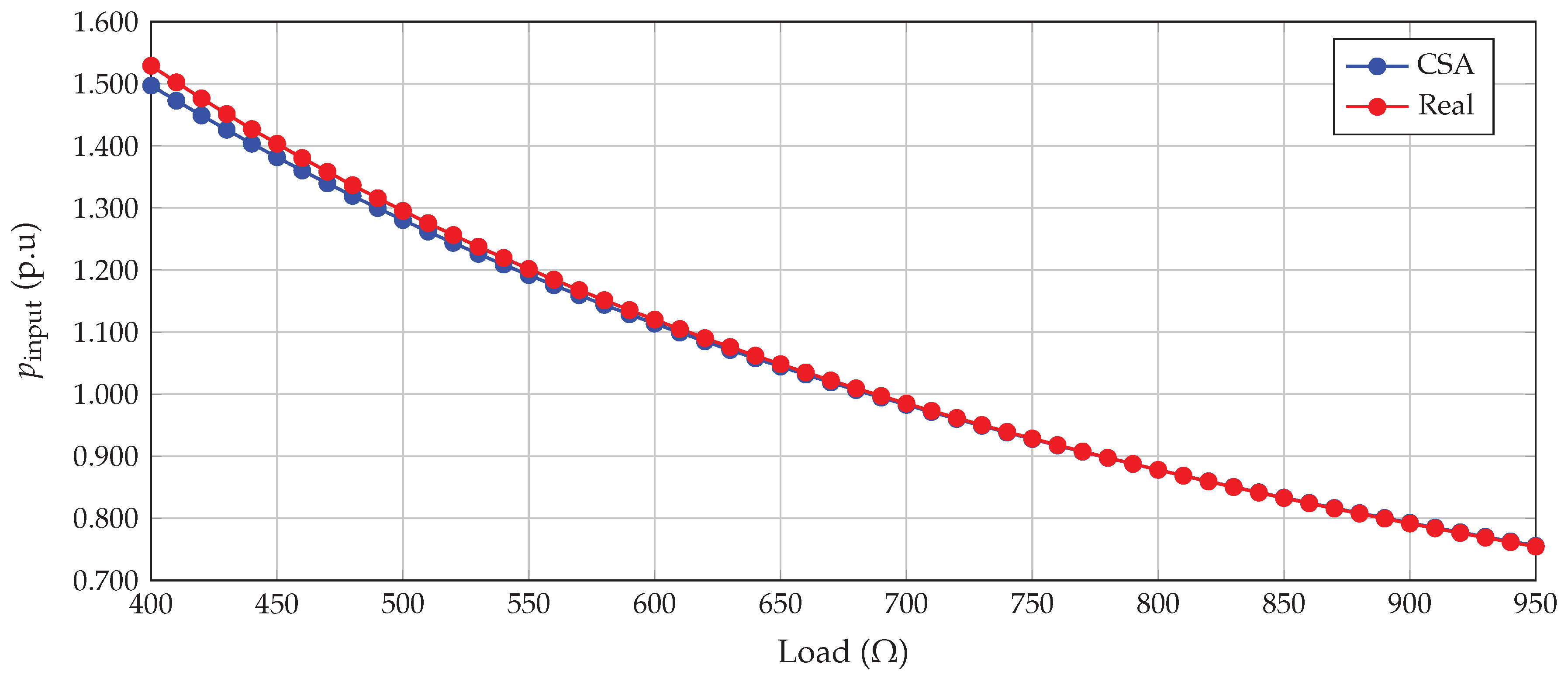2. Mathematical Formulation
To develop the mathematical optimization model that represents the problem of the parametric estimation in single-phase transformers, we consider the electrical equivalent of the transformer presented in
Figure 1 [
12]. Note that the electrical representation of the transformer includes two series branches that are associated with the copper losses in the primary and secondary windings (
and
resistances) as well as their magnetic flow dispersions (i.e.,
and
reactances). In the case of the magnetic core of the transformer, the resistance
models the active power losses caused by the parasitic currents induced along the metal plates that conform the transformer core; while the reactance
models the magnetic flow losses caused by the hysteresis process in the complete cycle of the sinusoidal input (i.e., magnetization current) [
12].
With the aim of simplifying the equivalent of the transformer, all the components from the secondary site are referred to the primary side (see Equations (
1)–(3)); in addition, based on the recommendation in [
8] for typical applications of the transformers in distribution levels, the magnetization branch can be directly connected to the transformer input, which allows the two series branches to become equivalent to one branch [
4]. The simplified transformer model is depicted in
Figure 2. It is worth mentioning that the movement in the magnetization branch is possible, since the total current through this branch under nominal operative conditions is as much as 3% of the input current [
12].
where
a is the ideal transformer relationship between primary and secondary sides, and
and
correspond to the equivalent resistances and reactances of the equivalent series branch.
From the equivalent circuit of the transformer depicted in
Figure 2, the set of constraints associated with Kirchhoff’s laws applied in its complex form is obtained as listed below.
where
represents the current in the secondary side of the transformer as seen in the primary side,
is the voltage in the secondary terminals of the transformer as referred to the primary side;
and
are the equivalent impedance loads referred to the primary side. Note that Equation (
4) represents the current calculation in the secondary side of the transformer as a function of the voltage input
. This equation is obtained by using a current division connected to the load impedance in
terminals. Equation (5) defines the total current input, which is obtained by applying the first Kirchhoff’s law at the node connected to the series and parallel impedances of the transformer. Equation (6) is defined with the application of Kirchhoff’s second law at terminals of the load.
Owing to the objective in the studied problem corresponds to the determination of the electrical parameters of the transformer, i.e.,
,
,
, and
, these variables are defined among their minimum and maximum bounds [
17]. These box-type constraints are listed from (
7) to (10).
where
and
represent the lower and upper bounds of the decision variable
y. An additional constraint reported in [
8,
17] is related with the predominant effect of the inductive series’ parameters regarding the series inductance. This constraint is defined as presented in (
11).
where
is bigger than 1.
Now the aim of the proposed study is to determine the electrical parameters of a single-phase transformer that minimizes the mean square error between the measured and calculated voltages and currents in the transformer terminals. To do so, we employ the objective function proposed in [
8], which is defined in (
11).
where
,
, and
are the current measures in the primary and secondary sides of the transformer as well as the voltage output in its secondary side, respectively. Note that we assume that the input voltage corresponds to the nominal transformer voltage, and the error between its measured and theoretical value is zero.
Remark 1. The optimization problem defined with the objective function (12) subject to the set of constraints (4) to (11) is a nonlinear programming model that can provide multiple local optimal solutions due to the nonconvexity of the solution space [17]. These complexities in the optimization model make necessary the usage of advanced optimization techniques to find the best optimal solution possible with minimum computational effort; for this reason, in this research is proposed the application of the CSA to solve the problem of the exact nonlinear programming model. All the details of the CSA are discussed in the next section.
5. Conclusions and Future Works
This work dealt with the proposition of the application of the CSA to the problem of the parametric estimation in single-phase transformers using voltage and current measures in their terminals. Numerical comparisons with the fmincon solver from MATLAB and the real data for the transformers reported in the current literature demonstrated that the CSA finds the best near-optimal values with minimum computational effort. Regarding the maximum estimation errors between the real data when compared with the CSA and the fmincon solutions, we found that in the case of our proposed method, these errors were 4.87%, 4.38%, and 6.00% for the 20 kVA, 45 kVA, and 112.5 kVA, respectively; while the fmincon found errors about 13.09%, 10.59%, and 7.86%, respectively. The CSA also arrived at better results in the case of the objective function estimation, when compared with the fmincon solver. The maximum estimation error in the case of the CSA was , while it was for the comparative method, both in the case of the 20 kVA transformer, which confirmed the efficiency of the proposed optimization approach to estimate parameters in single-phase transformers.
The effectiveness and robustness of the proposed CSA were supported by the proposed parametrization of this algorithm. This allowed finding the best compromise with respect to the objective function minimization and the required processing times to solve the problem. The selected parameters took the following values: , ; ; . The main advantage of these parameters was that the expected execution time is approximately 1 s for all the test transformers analyzed.
Numerical comparisons regarding recently developed approaches in the current literature showed that in the case of exact methods, the proposed CSA finds the best objective function value, followed by the fmincon approach, and in case of metaheuristic optimizers, it was the sine–cosine algorithm.
Future works can be developed: (i) to extend the application of the CSA to solve estimation problems in rotative machines such as induction, synchronous, and direct current motors/generators; (ii) to verify the efficiency of the proposed CSA with experimental validations in distribution transformers.
















